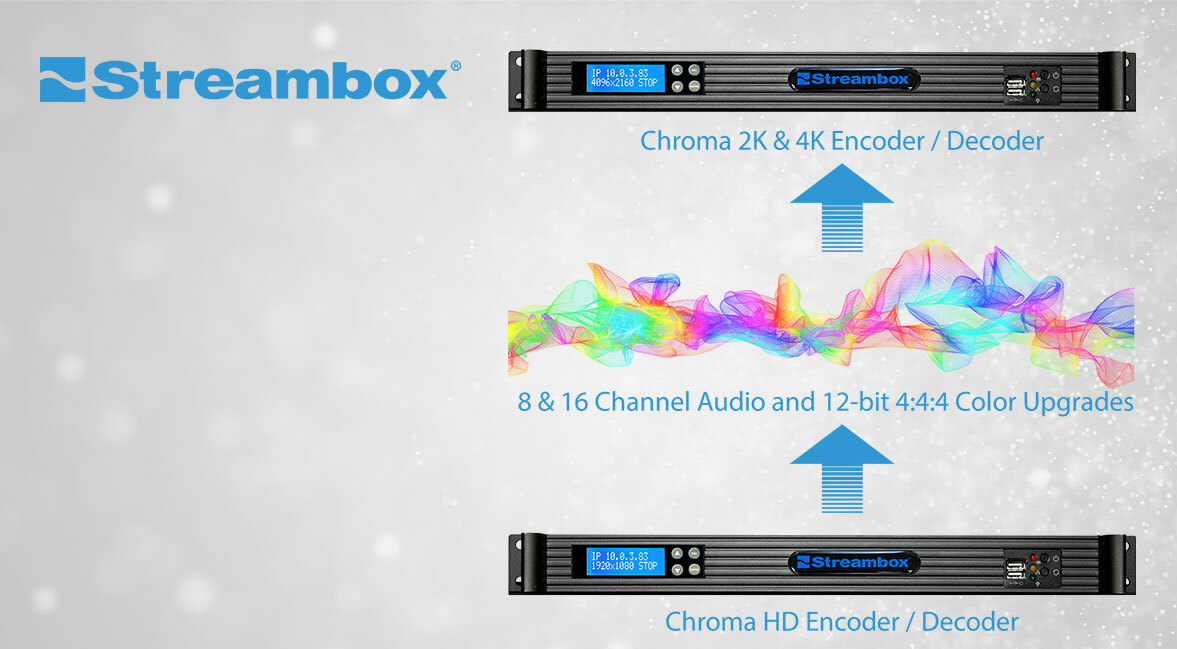
Why You Need to Upgrade to a Streambox Chroma
Software-defined Chroma systems offer flexibility and upgradability. Streambox technology provides unrivaled performance, reliability, superior quality, and minimal latency. Chroma offers superior quality media streaming over Internet and Multiprotocol Label Switching (MPLS) networks. Real-time transport provides efficient workflows and processes for post-production collaboration, broadcasting, and streaming live events.

The Chroma Encoder/Decoder platform is the latest generation high-performance, software-defined streaming solution from Streambox. Chroma offers a broad range of compelling feature and capability enhancements as compared to previous systems.
HDR
Display technology has changed dramatically and so the impetus has grown to implement new standards that can take full advantage of screens to show more of the brightness and colors that are seen in reality. High Dynamic Range (HDR) considerably increases the contrast ratio, which is the difference between the brightest and darkest light that can be shown on a display. This in turn helps produce much finer detail in the overall image.
HDR requires signal processing with at least 10-bit color depth, and this capability is being added or in some cases simply upgraded to video systems from cameras through to displays. While HDR content may be delivered to consumers with 10-bit processing, fully digital cinema HDR and Dolby Vision requires 12-bit precision with 4:4:4 Wide Color Gamut.
Wide Color Gamut adds to the range of colors that can be used with video signals, systems, and displays. The result is images that are more vivid, crisp and true to life. Colors are more vibrant, and objects appear to have greater depth. Just as 12-bit video signals are preferable to 10 bit, the same is true for color sampling rates. Even high-quality video is typically produced in a 4:2:2 color format where the chroma sampling rate is half that of the luminance rate, resulting in half the color resolution of what is possible. The best-looking pixels are attained using 12-bit 4:4:4 RGB or YCbCr color.
Chroma can be configured with SDI plus HDMI output that performs HDR metadata insertion that permits display of HDR content on compliant monitors without additional equipment. Most monitors with HDMI inputs require special metadata to be embedded to engage the HDR mode, and there is no standard for this metadata using SDI. For finished content at home, the metadata is embedded in the content, but this is not typically the case during production for performing live reviews. The Chroma decoder can be set to include HDR metadata so that other software and hardware are not needed, and additional configuration and support which is not easy to manage remotely is not required.
Full Chroma Sampling
The Chroma series of advanced performance hardware encoders/decoders not only support HDR as a standard feature, but some configurations can process the higher quality 4:4:4 RGB and YCbCr 12-bit video including 2K Stereo.
Enhanced Audio
Support of up to 16 channels of uncompressed PCM audio makes streaming of productions that incorporate technologies such as Dolby Atomos and DTS-X no
quality 4:4:4 RGB and YCbCr 12-bit video including 2K Stereo.
Video Interfaces
4:4:4 signals and 12-bit processing are enabled as part of a Quad Channel or 12G SDI option. This is integrated as a quad-link or dual-link BNC I/O that also includes 6G, 3G, with 10-bit processing. HDMI output with Rec.2020, HDR- 10 metadata support.
Multiple Resolutions
Chroma supports a range of high resolutions. While previous systems offered up to HD resolution, Chroma can surpass this with the ability to stream 2K, UHD, and 4K resolutions.
ACT L5 Codec
HDR, 10 / 12-bit processing, 4:4:4 signals, and higher resolutions are all enabled by adding a new ACT L5 codec implementation that adds to the prior L3 codec capabilities.
problem.
Software-Defined Platform
There are 3 standard Chroma models. Some capabilities can be added with a software upgrade. Chroma systems can function as just as an encoder, just a decoder, or both by how it is configured. The software-based media player is integrated
Performance Improvements
Higher streaming bit rates of up to 120 Mbps enables the delivery of cinematic quality video. A lower sub-second latency is obtainable on MPLS/Fiber and LAN networks. Even over the open public internet, a latency of 1-2 seconds is typical.
